Yoga BLOG
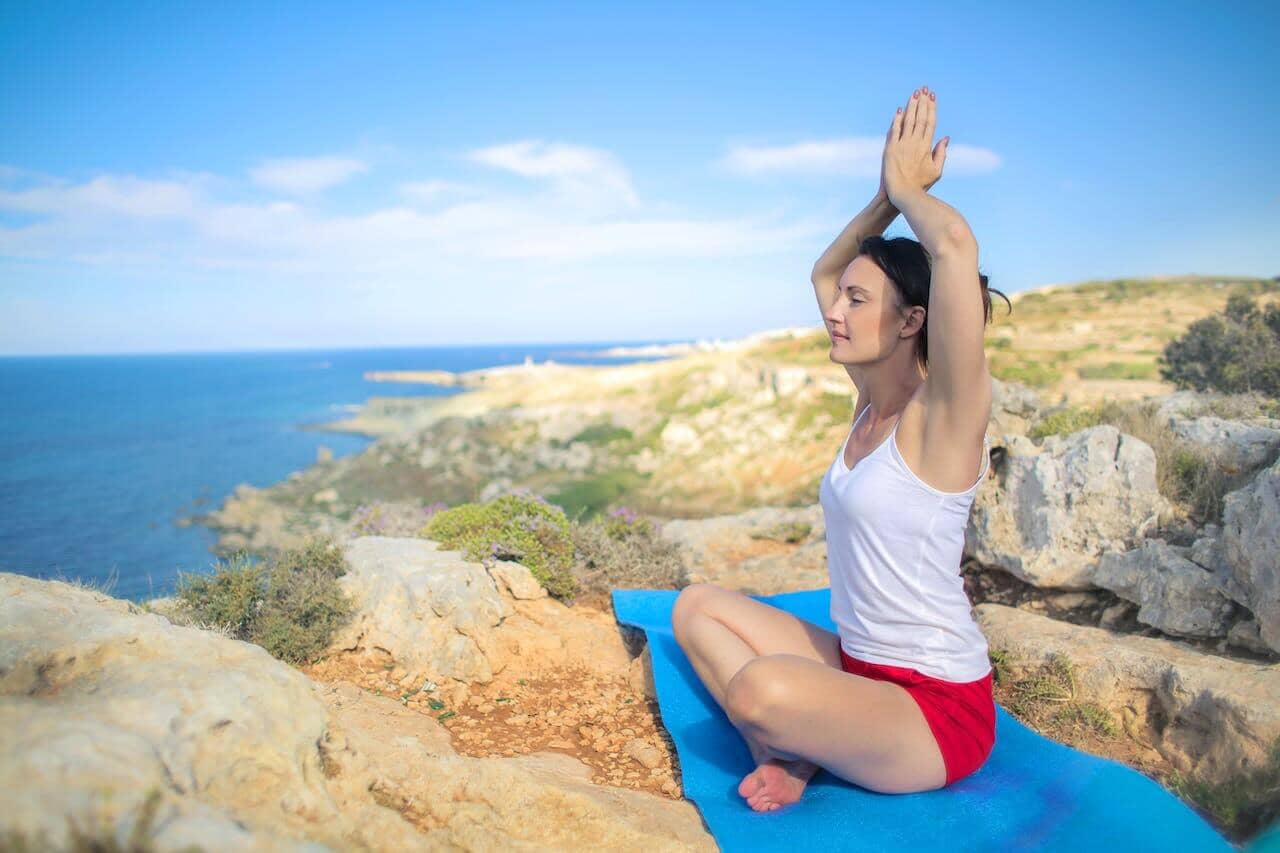
Pure relaxation: Yoga for connoisseurs
by Stefan
on Oct 31 2023
Yoga is a wonderful way to relax the body and mind. It's an ancient practice originating in India and has enjoyed widespread popularity worldwide in recent years. Yoga offers numerous benefits for health and well-being. It helps reduce stress, improve flexibility, and increase concentration.
The best tools for yoga
For many people, yoga is a way to keep fit, but also to find peace and relaxation. While some yoga practitioners meditate afterward, others retreat and treat themselves to a drink or other stimulant. Former smokers, in particular, find balance through yoga and are ideally equipped with Snuscorp products to help them stay smoke-free. To make the yoga experience even more enjoyable, various props are available. A yoga mat is an essential tool for providing a stable and comfortable surface. It provides good cushioning and prevents slipping during exercises. A yoga mat should be non-slip and easy to clean.
In addition to a yoga mat , yoga blocks can also be used to assist with stretching and find proper alignment. Yoga blocks are available in a variety of sizes and materials and can be customized. They are especially helpful for beginners or those with limited flexibility.
Another commonly used aid is yoga straps. These help deepen the stretch and increase the range of motion. Yoga straps are usually adjustable and can be adapted to individual needs.
Yoga for connoisseurs is a wonderful way to relax body and mind. With the right props, the yoga experience can be made even more enjoyable. Whether you're a beginner or an experienced yogi, yoga offers everyone the opportunity to relax and enjoy the moment.
Relaxation for body and mind
Yoga is not only a physical activity, but also a spiritual practice. It's about harmonizing body and mind and achieving deep relaxation. For those who enjoy it, yoga offers the opportunity to fully focus on the moment and leave everyday stress behind. Through the various yoga poses (asanas), the muscles are stretched and strengthened, while simultaneously calming the mind. Conscious breathing plays an important role in relaxing the body and calming the mind.
Yoga for connoisseurs can be practiced in various forms, such as Hatha Yoga, Kundalini Yoga, or Yin Yoga. Each form has its own focus and techniques for achieving deep relaxation. It's important to find a yoga practice that suits your individual needs and preferences.
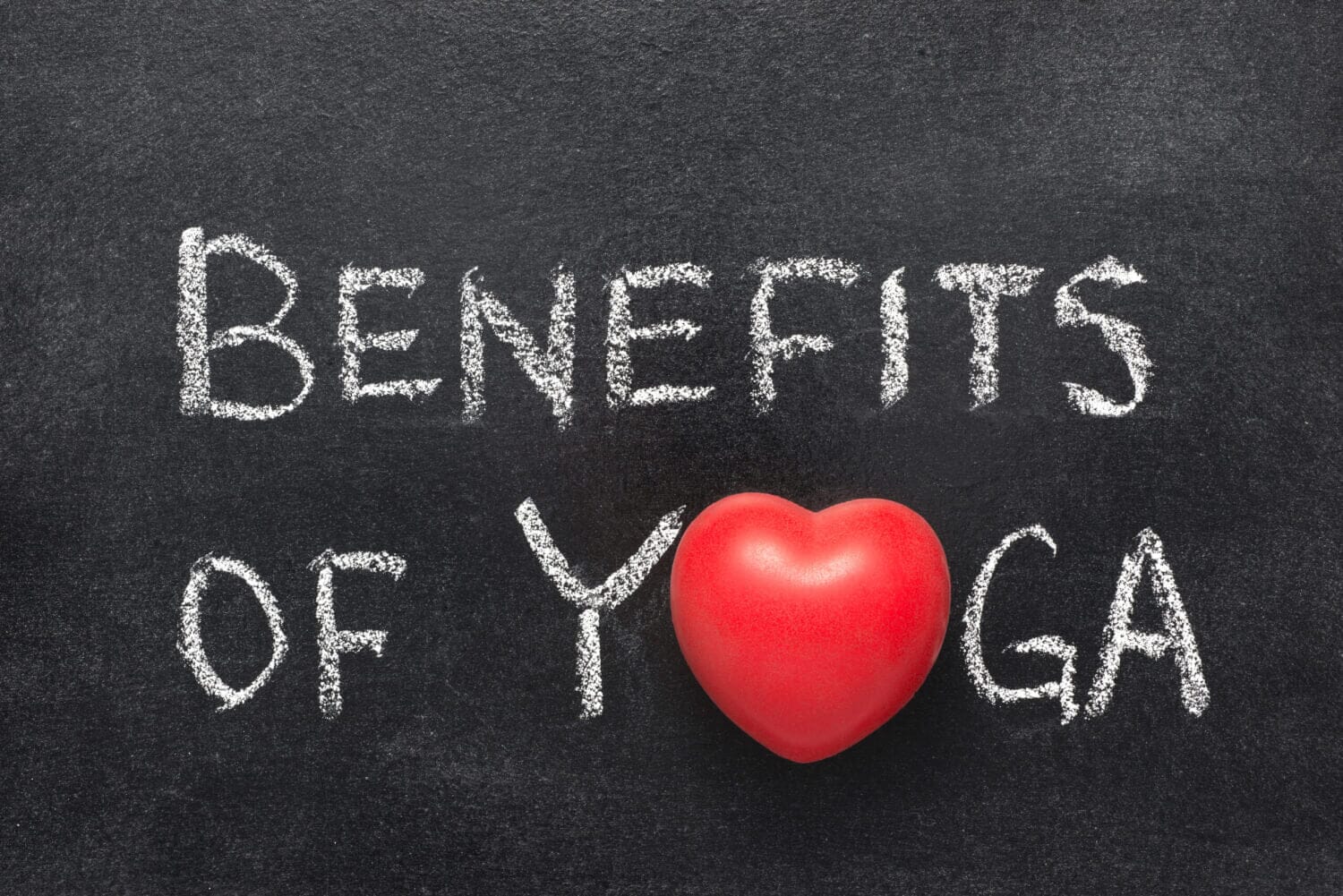
by Stefan
on Oct 29 2023
The main benefits of yoga for body and mind
The asanas from Buddhist teachings have a variety of effects on the body: Yogis report effects on body, mind, and soul. Do you know that feeling – you feel tired, exhausted, and completely disconnected from yourself? In this case, regular practice of Kundalini Yoga, Hatha Yoga, Ashtanga Yoga, Yin Yoga, or Vinyasa Yoga could be beneficial. In this article, we explain the 10 most important benefits of flow for your body and mind. Prepare to be amazed.
10 Benefits of Yoga for Body and Mind
If you have a stressful daily routine and want to make the most of your breaks or free time, you should definitely incorporate yoga on your favorite mat . The following section provides all the necessary information.
1. Improved mobility and flexibility
Sitting in front of a computer usually has negative effects on the body. The lack of exercise leads to rust over time. In this case, yoga is a good solution. The various asanas help you become more mobile and flexible. The exercises in Yin Yoga, for example, are specifically designed to stretch the body.
2. Reducing stress and tension
The asanas have different effects depending on the yogi. Nevertheless, many report a reduced sense of stress and less physical tension. Those who are under pressure all day should incorporate the asanas daily to strengthen their inner balance. The reason this practice is so effective is that yoga exercises have a direct influence on the autonomic nervous system. During the exercises, you also focus on your breathing, which in turn affects your perception. Your breathing slows down, and tension throughout the body decreases.
3. Increase endurance and muscle strength
Depending on which yoga exercises you practice, you can both bring relaxation into your stressful everyday life and strengthen your entire system at the same time. Muscles are stressed and strengthened during any physical activity. For example, if you practice a strenuous Ashtanga or Vinyasa Flow, you can be sure that your muscles will build with regular practice. Your strength will increase, and your endurance will also improve. The latter can be built up particularly through brisk sun salutations. If you're more focused on strong abdominal muscles, the upward-facing boat pose (Ado Mukha Navasana) can be a good option. Locust or bird pose will help you build your back. Warrior poses (I and II) are ideal for training your legs.
4. Improved breathing abilities
If you decide to practice yoga regularly in your life, you can expect your breathing to improve as well. Breathing is a key aspect of the practice. Each pose has the right timing for inhaling and exhaling, meaning you focus on conscious breathing. In the stresses of everyday life, we often breathe too shallowly, meaning our bodies aren't supplied with enough oxygen. During a yoga flow, however, a yogi focuses so intensely on the breath that the entire body, all organs and cells, are supplied with sufficient oxygen.
5. Increased concentration skills
If you often struggle with a lack of concentration, yoga is a good way to change this. When you practice a yoga flow, you consciously surrender to the moment. Your brain can be relieved, thus increasing your focus on what is essential. If you can concentrate on something specific with the help of yoga, you can implement this in your everyday life. Those who manage to focus their energies, actions, and abilities achieve much better results with significantly less effort. If, on the other hand, your focus is very scattered, it is not uncommon that you can hardly concentrate and achieve poor results. A subsequent meditation on your cushion can further increase the calm in your body and mind.
6. Increase self-confidence
Self-confidence means having faith in yourself, knowing what you're doing, and knowing that your actions are effective and have an impact. Practicing yoga regularly can potentially boost your self-confidence. You know how your body feels and notice improvements. At the same time, you're connected to yourself, allowing you to trust yourself and your body. Furthermore, your connection to your own voice is strengthened.
7. Stabilized blood pressure
Many people suffer from various physical complaints. One of these is high blood pressure, which can sometimes lead to other symptoms. Yoga can help support your blood pressure. When you are calm, your blood pressure drops. Because yoga has a direct effect on your stress levels, you can expect high blood pressure to drop again. Of course, this should be discussed and clarified with a doctor.
8.Improved sleep rhythm
If you have trouble falling asleep, it could be due to various factors in your life. In this case, you should examine what's keeping you awake. Is it thoughts that are weighing on your mind, worries that are weighing on your mind, eating too much before bed, or the wrong room temperature? Ask yourself what the cause is and change it. For many people, it's the swirling thoughts that disrupt their nighttime rest. Yoga is effective in calming the chaos of thoughts and thus optimizing falling asleep and your overall sleep rhythm. To increase the effect, you should practice Yin Yoga and relaxing postures, including Pranayama (breathing exercises).
9. Strong immune system
When your mind and body are in harmony, this has a direct effect on your immune system. If you want to stay healthy, you should exercise your body daily. Yoga is a great way to keep yourself fit and vital all year round.
10. Increased happiness and well-being as well as improved vital energy
Do you want to do something for your psyche and finally feel happier and more fulfilled? Then Buddhist asanas are the perfect way to connect more with your body and feel relaxed and carefree. Through yoga, you can realize that you don't need anything external to be happy. You focus on your inner self and strengthen your connection to yourself. This automatically leads to a heightened sense of happiness and an improvement in your well-being.
You'll also be able to perceive your energy much more clearly. This is especially achieved with the help of various exercises from Kundalini Yoga. Using special asanas, you move your life energy from your root chakra to your head. This leads to increased vital energy throughout your entire system.
Conclusion
Yoga has a significant impact on the body, mind, and soul. Therefore, you should incorporate the exercises into your daily routine to maximize its effectiveness and benefits—especially if you have a weak immune system, a lot of stress during the day, and struggle to concentrate.
Do you practice yoga regularly? If so, what benefits can you confirm?
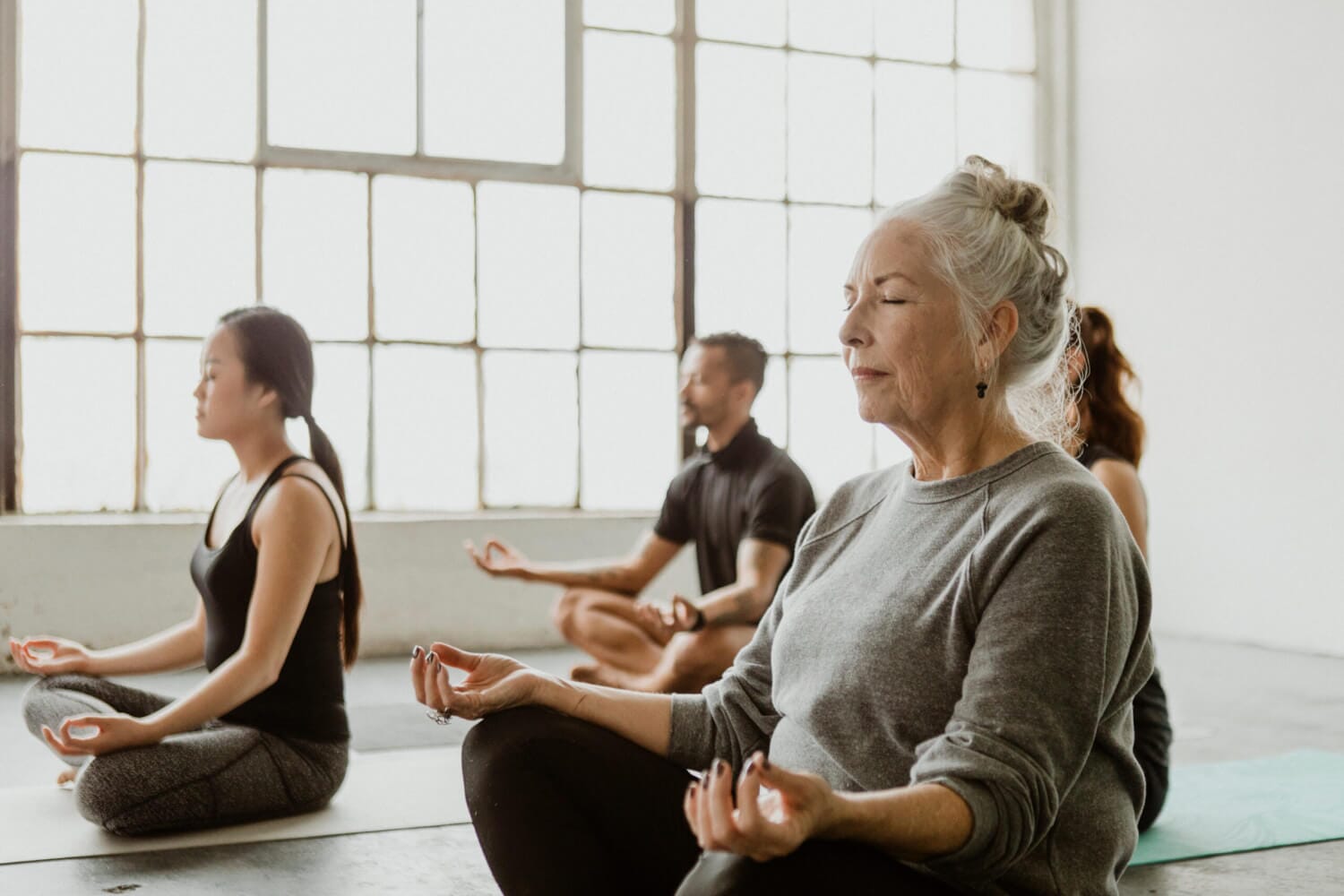
by Stefan
on Oct 17 2023
Yoga and aging: How can yoga help you stay healthy and vital as you age?
No matter your age, you can theoretically practice yoga your entire life—whether you're 50, 60, or 70. As long as you feel vital and fit enough, the asanas from Buddhist teachings are ideal for staying physically, mentally, and spiritually fit. The advantage is that this is a form of exercise that has a holistic effect on your entire system. This article will show you the most important benefits and effects on your body, mind, and soul. You'll also learn what you should consider as a beginner.
1. Introduction: Why yoga is a good choice for older people
Older people who want to be more active can practice yoga exercises daily. Thanks to the various styles, everyone can find something suitable for themselves. If you belong to the older generation and desire more energy and vitality, you can start with yoga – you will quickly notice the positive effects of yoga practice on your quality of life. Many yogis notice that they become more flexible and stronger. Therefore, yoga is an ideal way to shape, stretch, and mobilize the entire body, even in old age.
2. The effects of yoga on the body and mind of the elderly
Everyone needs exercise. Even older people shouldn't just sit at home all day and barely move. Depending on the physical ailments, numerous yoga exercises can be performed without any problems. Senior yoga naturally takes age-related ailments into account. Those who practice yoga exercises daily for a while will notice the following changes:
Yin yoga makes you feel more at peace with yourself. Furthermore, these long-held poses allow you to find your center, strengthen your body's flexibility, and loosen your fascia.
Of course, the exercises also help you to be more coordinated.
Some age-related symptoms can diminish and be reduced.
If you are looking for relaxation, Yin Yoga or other slow yoga styles are perfect for finding peace.
Vinyasa Yoga helps you strengthen your muscles and improve your fitness.
3. Which types of yoga are best for seniors
If you want to start practicing yoga as you age, you should be clear about what you want to achieve. Each yoga style has different effects on the body. Yin yoga, for example, is particularly suitable for seniors who are no longer as flexible and want to improve this. Vinyasa yoga can be an ideal routine if you want to increase your endurance and vitality. You can also incorporate Hatha yoga into your yoga routine. Strenuous styles like hot yoga or power yoga should be avoided unless you are very fit.
In the following section we will show you some ideal positions on the mat :
Cat Pose (Marjaryasana) : This exercise is part of the well-known Cat-Cow Pose. Here, you stand on all fours and round your back.
Warrior Pose (Virabhadrasana) : In this asana, you stand with one leg forward and the other back, your knee positioned over your heel, and your heels aligned. Lower your upper body and hold this position. Your arms can either be raised high in the air or you can hold one arm forward and one back.
Child's Pose (Balasana) : If you want to relax and let go, try Child's Pose. Here, you squat down and bend your upper body forward. Your legs are on the floor, and so is your upper body. Your arms point forward.
The entire Sun Salutation exercises are ideal for training endurance, strength and mobility.
4. What should you keep in mind when starting yoga classes as a senior?
If you're looking to start your yoga practice but are still a complete beginner, that's okay. The first step is to consciously decide to pursue this path and stick with it.
Before you begin, please note the following points:
Yoga can be just as strenuous as regular exercise. Therefore, you should have all your physical conditions checked out first to ensure you're allowed to practice yoga. Your doctor can explain which areas of your body you should avoid. Because yoga is so versatile, you can practice asanas that engage other parts of your body and don't overtax your weak points.
Start slowly and progress. Many yogis want to do the most challenging exercises right from the start. This isn't advisable, especially as you get older. Always pay attention to your body and its reactions.
Get a comfortable, non-slip yoga mat, a comfortable meditation cushion , and a blanket for shavasana and meditation. Comfortable clothing is also necessary to be able to perform all the exercises smoothly and without constricting your body.
Ideally, you should sign up for a class specifically geared toward seniors. This way, you can learn all the poses correctly from the start, thus avoiding mistakes, sprains, or other physical problems. The yoga instructor will show you what to pay attention to and explain everything so you can implement it effectively.
5. How can you maximize the benefits of yoga as you age?
To intensify the effects of yoga practice, the following tips apply:
You should definitely pay attention to your diet. If you eat a balanced, healthy, and nutrient-rich diet, you'll automatically notice it in your fitness. Certain exercises will be much easier with a well-nourished body.
Regularity plays a key role. That's why it's even more important that you set aside at least 15 minutes each day for your practice.
Be sure to include your breath. If you breathe as directed in the video or by your yoga teacher, you will become even more relaxed and calm.
Practice different styles so that you engage your entire body. Once your entire body is strengthened, you can move on to increasingly difficult exercises.
6. Conclusion: Why yoga is an ideal way for seniors to stay fit!
As you can see, yoga is a holistic tool for bringing your body, mind, and soul into alignment and harmony, even as you age. This means that through this practice, you invite greater well-being, balance, and vitality. Your body is strengthened, mobilized, and stretched at the same time. Incorporating your breath ensures that you are more relaxed and calm. The more often you practice yoga, the faster you will see and feel the results – and this works even beyond the age of 50. Because the asanas are gentle, powerful, energetic, and dynamic, you get your entire circulation going.
Are you a little older and have you practiced yoga before? If so, what are your experiences?
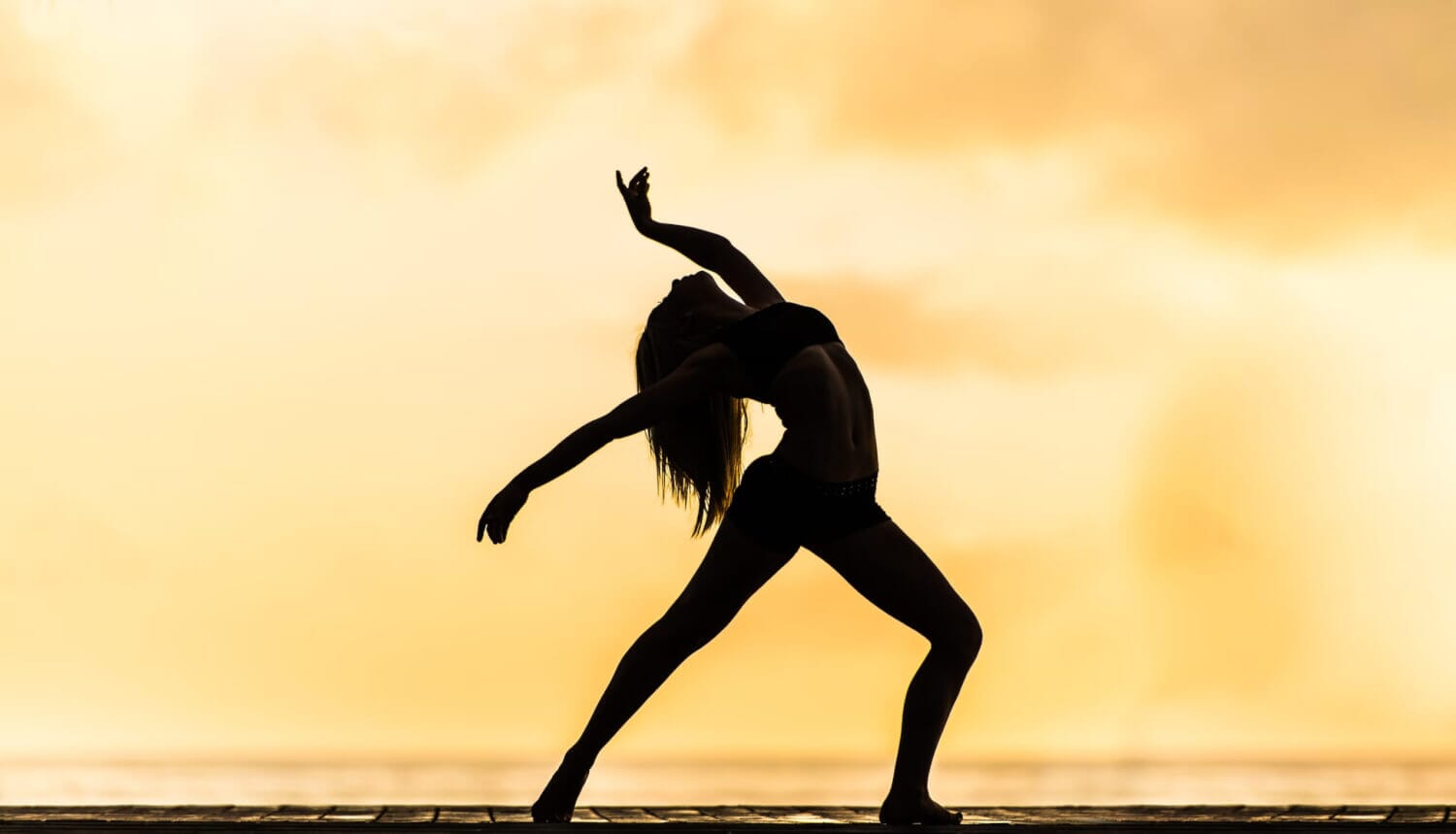
Dextrose: Natural energy for body and mind
by Stefan
on Oct 13 2023
Dextrose, often known as grape sugar, is a simple sugar that occurs naturally in many foods. For many, it provides a quick source of energy, especially in moments when the body and mind need an extra boost.
But how exactly does dextrose work, and why is it so effective as an energy source? Dive with us into the fascinating world of this sugar.
A sweet insight into nature
You may know it as glucose, but did you know that dextrose is scientifically recognized as one of the most efficient monosaccharides—simple sugars? It's far more than just a sweet temptation in your favorite fruit.
This natural sugar, found in many fruits, honey, and even some vegetables, has a remarkable ability: the human body can rapidly metabolize dextrose, allowing it to enter our bloodstream directly as glucose.
This rapid conversion makes it a sought-after ingredient in many dietary supplements and emergency solutions.
The turbo for brain and muscles
We all know the feeling: our thoughts seem to be stuck, our concentration wanes, and a mental sluggishness settles over us – often referred to as “ brain fog .”
In such moments, our brain, whose main energy source is glucose, craves a boost. Dextrose, thanks to its rapid conversion in the body, can help. By consuming dextrose, blood sugar levels are quickly raised, allowing brain fog to dissipate.
But that's not all: Muscle cells also benefit from this quick energy source, especially after an intense workout . Whether it's to combat mental sluggishness or promote physical regeneration, dextrose offers support.
More than just energy
While sugar often gets a bad rap, dextrose shows that it has more to offer than just empty calories. In emergency situations, especially for diabetics, dextrose can be a lifesaver by rapidly raising blood sugar levels.
After strenuous workouts, it can help replenish glycogen stores in combination with protein, thus promoting faster recovery. And in a medical context? Hospitals administer it intravenously to both prevent patients from dying of thirst and stabilize blood sugar levels.
Dextrose is definitely not just a sweet additive, but also a medical all-rounder.
A pleasure with responsibility
As with many wonderful things in life, dextrose is all about the right amount.
While it may be a great energy booster , excessive consumption can send blood sugar levels into a rollercoaster-like pattern, causing fatigue and dizziness. Furthermore—and this is something we should always be aware of—excessive sugar consumption can contribute to long-term health problems.
Therefore: Enjoy dextrose, but do so consciously and in moderation. Responsible use allows you to reap its benefits without taking risks.
Conclusion
Dextrose, as a natural energy source, offers numerous benefits for both the body and mind. It can be a great help in situations where you need a quick energy boost. At the same time, it's important to be aware of the potential drawbacks and enjoy it in moderation.
Maintain a balanced diet and use dextrose only when you really need it. This way, you can maximize its benefits without harming your health.
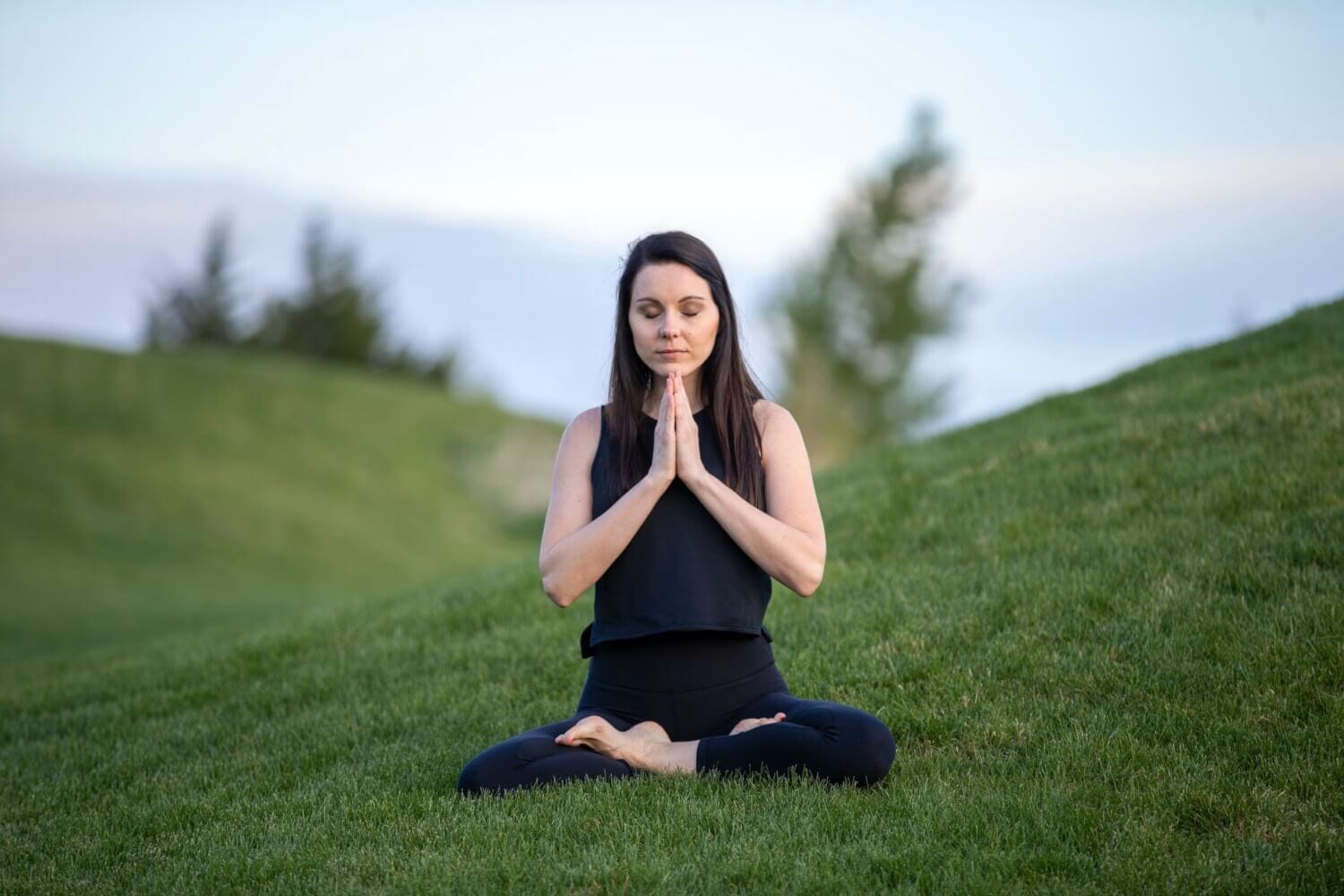
How yoga and meditation can strengthen the psyche
by Stefan
on Oct 08 2023
Modern lifestyles present many of us with challenges. Stress, burnout, and anxiety are just some of the psychological problems people suffer from.
While there are many ways to address these challenges, yoga and meditation have proven to be effective tools for strengthening the psyche. But how can these ancient practices help us today?
Bringing body and mind into harmony
One of the most remarkable goals of yoga is to establish a deep harmony between body and mind. This isn't just about flexibility or physical fitness—it's a journey of self-awareness.
As you twist and turn in various asanas (yoga poses), you'll learn not only the limits of your body, but also those of your mind. With every pose you assume, as well as every conscious breath you take, you build a bridge between physical sensation and mental presence.
It's about listening, accepting, and challenging. For example, if you hold a pose that's particularly challenging, you learn to cope with discomfort, breathe, and respectfully recognize your limits.
Calm the mind through meditation
Meditation, often misunderstood as simply "doing nothing," is actually a profound exercise in self-reflection and the mind. When you meditate, you don't try to stop or control your thoughts.
Rather, you learn to observe what's going on in your mind without judgment. Over time, you develop a skill called "metacognition," awareness of your own thinking. This means you'll begin to see your thoughts and emotions from a bird's eye view, rather than being swept along by them.
You learn to gaze upon the stormy sea of your mind like a silent observer, watching the waves come and go without being swept away by them. In this calm state of meditation, you often find answers, clarity, and above all, peace.
Developing emotional resilience
Emotional resilience is more than just "making it through" difficult times. It's the art of learning from challenges, recovering quickly from setbacks, and even emerging stronger. In today's hectic world, where we are constantly confronted with external demands, yoga and meditation can help us center ourselves internally.
For those who are confronted with sudden bouts of anxiety or uncertainty, a panic attack test can provide insight into the intensity of these feelings. Regardless of the results of such tests, yoga and meditation teach us to observe our emotions without hasty judgment using targeted breathing techniques and mindfulness exercises.
With time and practice, challenges are no longer seen as insurmountable obstacles, but as opportunities for growth
The power of community
At a time when many people feel isolated or alienated, the communal practice of yoga and meditation offers a lifeline. It's not just the individual experience on the mat or meditation cushion that counts, but also the shared experience with like-minded people.
Community classes or retreats create a space of acceptance, listening, and mutual understanding. People share not only physical and spiritual experiences, but often also life stories and perspectives.
The scientific perspective
It is fascinating how the ancient practices of yoga and meditation are supported by modern scientific research today.
Numerous studies have examined the positive effects of these techniques on the brain and psyche. For example, neuroscientific research has shown that regular meditation can actually change the structure and function of the brain.
Areas associated with self-awareness, empathy, and emotion regulation often show increased activity and density. Research has also confirmed that yoga can significantly reduce cortisol levels, a hormone released in stressful situations.
Conclusion
Yoga and meditation are more than just physical exercises or relaxation techniques. They are tools that can help you strengthen your psyche and develop a deeper understanding of yourself. The benefits are evident on both a personal and scientific level.
Whether you're looking for inner peace, want to manage daily stress, or simply want a way to connect with your inner self, yoga and meditation can help you live a more fulfilling, healthier, and happier life.

Why your terrace is the perfect alternative to a yoga studio
by Nick
on Sep 25 2023
Sometimes paradise really is right on your doorstep. Especially now, at a time when your home is increasingly becoming a place of retreat and relaxation, it's clear that you don't necessarily have to go to a specialized studio to practice yoga.
Your own patio could prove to be the perfect place to harmonize body and mind. Learn why your patio could become a yoga oasis.
Direct connection with nature
Practicing yoga on your own patio allows for a direct connection to nature, which can be both renewing and refreshing. Another benefit would be a patio cover from Renson, which allows you to practice outdoors even in light rain or strong sunlight while still enjoying the natural surroundings.
You can enjoy the cool morning breeze, the warm afternoon light, or the peaceful starry sky at night. The natural sounds of birds, rustling leaves, or flowing water can serve as soothing background music for your practice.
Flexibility in scheduling
When you move your yoga practice to the terrace, you enjoy unparalleled scheduling flexibility. You're not tied to the fixed times of yoga classes and can structure your practice according to your own rhythm. Whether early in the morning to start the day energizing or late in the evening for relaxation, you have the freedom to plan your yoga sessions to fit perfectly into your daily routine.
This flexibility can also help your outdoor yoga practice become a consistent and regular habit, helping you live a more balanced and harmonious life.
Personal and individual space
Your terrace offers a personal and individual space where you can tailor your yoga practice to your liking. Here, you can create your own personal oasis of calm, decorated with plants, candles, or other elements that create a calming atmosphere.
The opportunity to create a personal sanctuary where you feel comfortable and safe can add a whole new dimension to your yoga practice and help you establish a deeper connection with yourself and your surroundings.
Economic benefits
Another aspect that shouldn't be neglected is the financial aspect. Yoga studios can sometimes be quite expensive, especially if you attend classes regularly.
By using your patio as a yoga space, you can save a lot of money, which you can instead invest in high-quality yoga equipment or workshops to deepen your knowledge.
Promoting creativity and self-discovery
On your patio, you are the master of your own yoga practice. Without the guidance of a teacher, you can explore for yourself which movements and positions feel best for your body. This could be a way to foster your creativity and develop a practice specifically tailored to your needs and goals.
In addition, self-guided practice on your patio gives you the time and space to learn more about yourself, which can lead to self-discovery and inner peace.
Conclusion
Your home patio can easily become a sacred space for your yoga practice, offering numerous benefits. From the immediate connection to nature and scheduling flexibility to fostering creativity and self-discovery, your patio offers a rich and fulfilling alternative to the traditional yoga studio. Furthermore, the financial aspect and the opportunity to create a more personal and customized space can help make your yoga practice both more sustainable and personally enriching.
There's no question that practicing yoga on your own patio can be a refreshing and renewing experience worth exploring. It's time to roll out your yoga mat, open the patio door, and embark on a journey of self-discovery and wellness that begins right outside your front door.
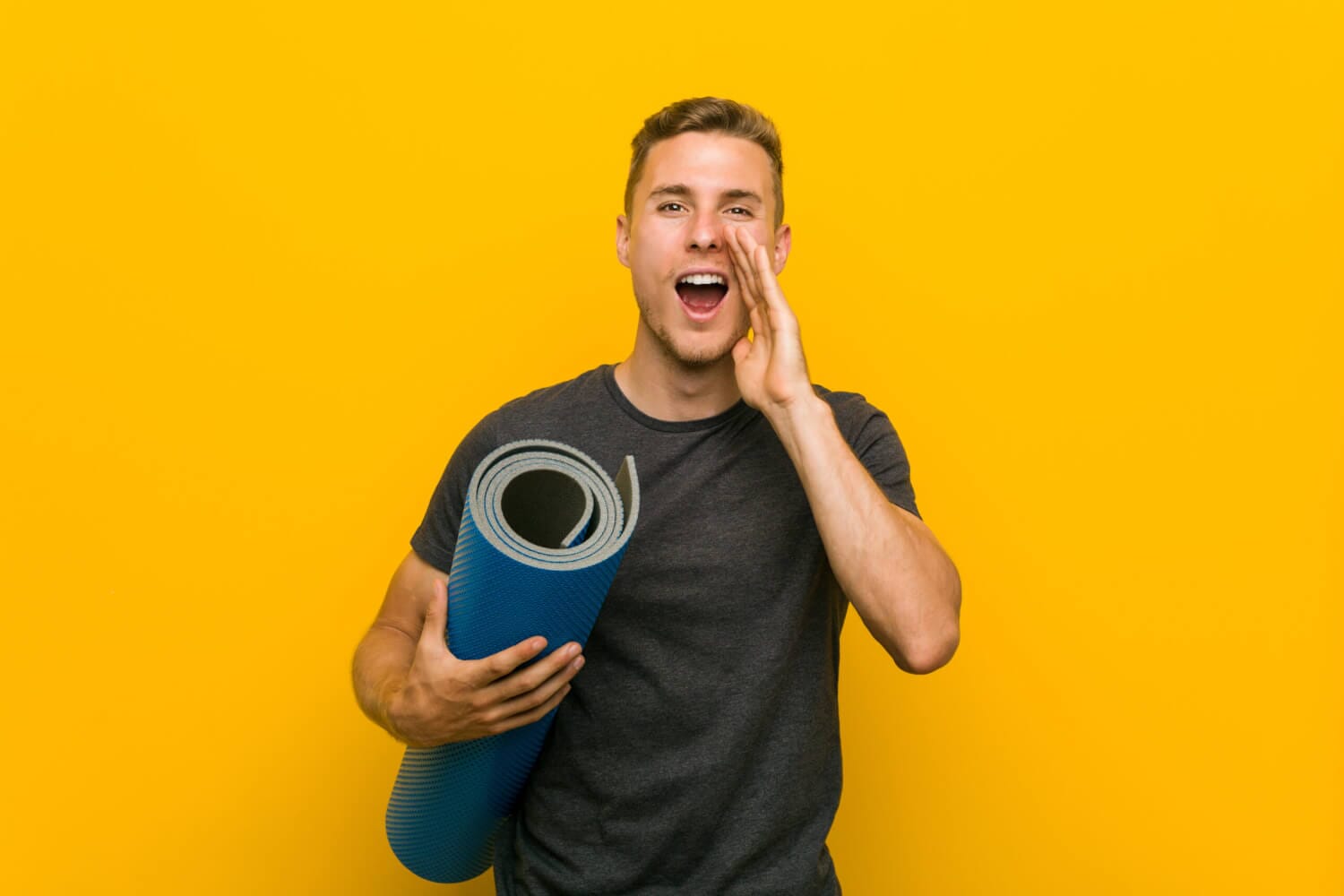
by Stefan
on Sep 22 2023
Yoga for the voice: How yoga can help strengthen your voice!
The sound of your voice depends, among other things, on your mood. Did you know that? It's certainly an interesting fact, and it means you can intentionally influence how it sounds. This is especially true because it reflects emotions and resonances. This is how the sound changes. Learn how you can use yoga to strengthen and improve your voice in this article.
The importance of the voice
We humans communicate with our own voices; each individual has a unique style. Animals, just like humans, can communicate using tones, sounds, and noises. We have the ability to use an almost infinite repertoire of languages, sounds, and tones. If you speak and feel insecure or annoyed, the person you're speaking to will usually recognize this pretty quickly. Your mood will be quickly conveyed.
Every voice is unique and no two are alike—much like a fingerprint. It is directly connected to the body, mind, and soul.
The larynx is responsible for producing the voice. It is freely suspended and located between the pharynx and the oral cavity.
How can yoga affect the voice?
Anyone who has already practiced various asanas on the mat knows the importance of Buddhist teachings for holistic health and the harmonization of body, mind, and soul. But that's not all—yoga can do even more. There are various techniques for harmonizing your voice. Furthermore, Buddhist physical exercises are often part of holistic vocal training.
Simply put, speaking or singing clearly requires a large lung capacity. You can achieve this by regularly practicing breathing exercises. At the same time, this generates the vital energy you need for a pleasant singing or communication experience.
Useful breathing exercises to train your voice!
Those who practice breathing exercises regularly will certainly notice that their voice sounds firmer and more beautiful. Kirtan singing (the singing of spiritual songs from the yogic Indian tradition) will also help with this.
Everyone has their own individual pitch at which speaking is easy and effortless. However, if you practice speaking or singing in higher or lower pitches, you need to do so with the appropriate effort. This means you'll have to put in significantly more effort.
Helpful breathing technique
If you want to optimally support your vocal potential, you can sit on your meditation cushion daily and perform breathing exercises. The positive effect is that your voice is optimally prepared for the demands of singing.
If you breathe in and out deeply, you will notice that the interior space of your body becomes significantly wider.
Another benefit of pranayama is that you supply your body with more oxygen, thus improving your overall circulation. It can also strengthen the respiratory system and train the diaphragm—which is beneficial for singing.
A great breathing exercise is Ujjayi breathing , which produces the familiar snoring sound. This occurs by consciously closing the glottis. This breathing technique is often practiced during various yoga sessions. By controlling the vocal cords, breathing can be easily regulated.
Three-chakra method of voice training
In addition to pranayama exercises, there is another technique: By connecting the three areas (throat, heart, and belly), you can adjust, strengthen, and improve your voice.
The abdominal chakra is where the power to speak develops. Therefore, it is advisable to practice abdominal breathing daily. The heart chakra is where emotions reside. This means that joy or pain is channeled from there into the tone. The chest must always be open. You can achieve this with certain heart-opening poses (such as the bridge, etc.). The throat chakra is responsible for transmitting prana – this is how the voice develops.
The power for voice creation develops in the stomach, is influenced by the emotions in your heart space and expressed through your throat.
What sounds can you use to stabilize yourself?
To energize your entire body, mind and soul, you can use different sounds.
For example, the primal sound "AUM" is considered ideal for grounding you and making you feel better.
First, focus on the inhalation and then, as you exhale, on the vowel "A." Repeat this a few times, then move on to "U" and "M."
Physical asanas for a better voice
In addition to pranayama and reproducing sounds, physical exercises are also important for improving the voice.
It is important that you focus on opening the chest.
These asanas can support you:
a) Fish (Matsyasana)
Lie on your back and raise your upper body. Your arms stabilize this position while you open your chest. The top of your head rests on the mat, as do your legs, buttocks, and forearms.
b) Cobra (Bhujangasana)
Here, you lie on your stomach on the mat and open your chest. Your forearms rest on the floor. Your chest is bent forward, and your forearms press toward the mat.
These exercises can help you optimally prepare your chest for breathing techniques.
Have you already tried these breathing exercises or postures to train your voice? If so, what were your experiences?
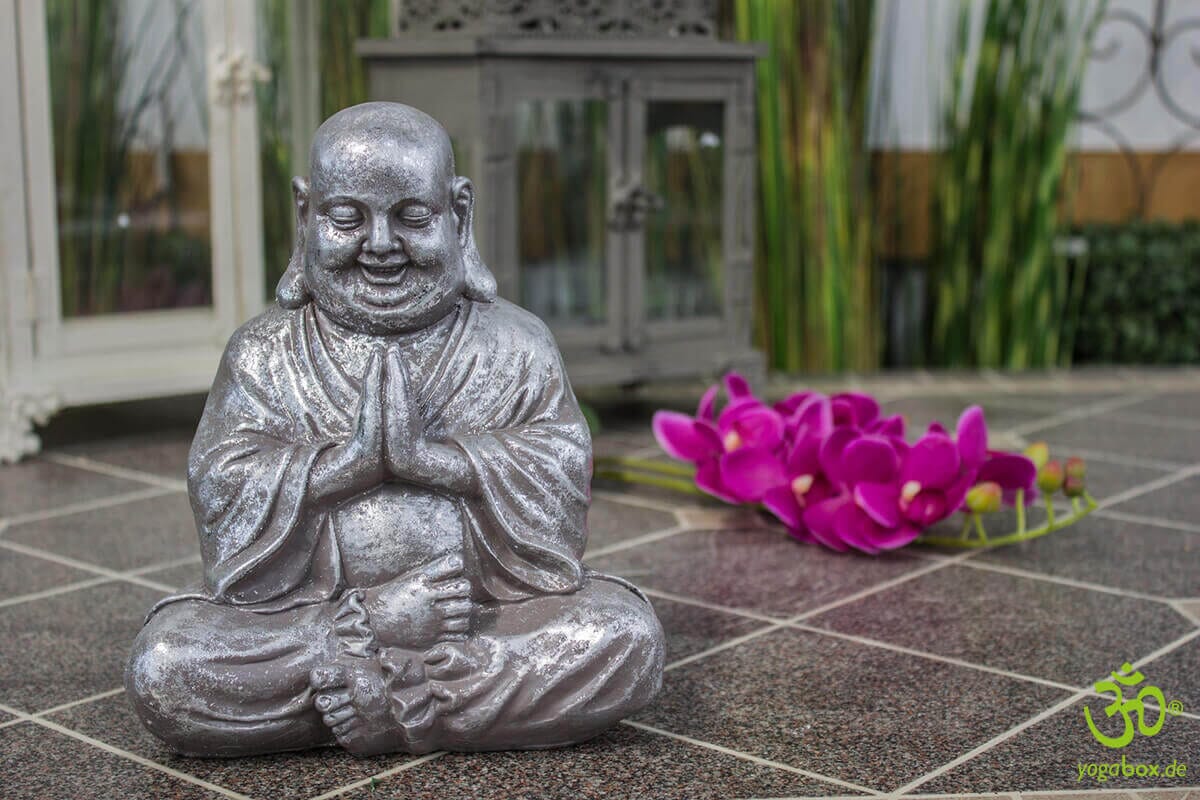
by Nick
on Sep 08 2023
Yoga and the Mind Yoga is good for the mind—and certainly one of the reasons why many people practice it. Some prefer the more physical Hatha Yoga or even Power Yoga ; others love Kundalini Yoga , which also incorporates intensive breathing and even singing. The particular style is a matter of personal taste. You are also free to try other forms of yoga every day, or to incorporate meditation and breathing exercises . This takes up very little time and can open up entirely new spaces within yourself.
Physical exercise reduces stress
Whatever you choose, you'll feel better both physically and mentally. Physical yoga is like moderate exercise, and as we all know, it can make you happy; in any case, it's healthy for the body and increases contentment. In this respect, yoga, through the strenuous asanas alone, helps reduce stress and cope better with everyday worries. All you need is a simple mat ; of course, it can also be a beautiful one to make you feel even more comfortable (our tip: get one as a gift!). Or you can take a rainbow mat—after all, favorite colors are wonderful mood boosters.
Breathe calmly
Other types of yoga exercises calm your mind very quickly, even for beginners. It's not for nothing that we spontaneously advise agitated people to take a deep breath first. This can be achieved with calming yoga breathing exercises. Among them are very simple ones that encourage deep breathing into the lungs, sides, and abdomen; others involve nasal or tongue-and-mouth breathing – in either case, you need to concentrate; and this will calm your agitated senses. Focus and mindfulness – these are appropriate keywords, and not just for breathing. Perhaps you know the feeling of flow we experience whenever we are completely present with ourselves and the task at hand. We literally lose track of time, are awake and yet somehow lost – and then feel relaxed and happy. This can also be achieved through yoga.
Block out the world for a moment
Even simple meditation helps and is not difficult to learn. It focuses your attention on one point or lets your thoughts wander. Choose a comfortable meditation cushion or sit on a chair . Your eyes are half or completely closed and at first you just sense the peace and quiet of the room. Simply listen to the sounds of your surroundings, don't judge them: hear the children on the street, a passing car, birdsong or your peacefully running washing machine. Try your exercises outside and sit comfortably on a park bench, for example. Let yourself sink in, enjoy the quacking of ducks, the wind in the trees and the babbling of a brook. Wherever you are: in any case, within a few seconds you will feel your psyche recover. There is only you and this moment; for a few minutes or half an hour the rest of the world is unimportant. Don't let a cell phone ring disturb you (i.e. turn it off beforehand) and find a place where people aren't constantly walking past if you don't want to be suddenly spoken to and disturbed during your practice.
Yoga and more
But is this still yoga? Well, that depends on your interpretation. Meditation is a part of yoga, but it can also stand alone. If you want to relax permanently and also do something for your metabolism and blood pressure, yoga exercises of all kinds are a very good method. With breathing exercises and meditation, you simply have even more options for targeted relaxation in a very short time, even on the go. Relax this way, for example, in a park, on the train, or during a stressful company meeting—in other words, anywhere where you can't practice asanas. Image © tundephoto
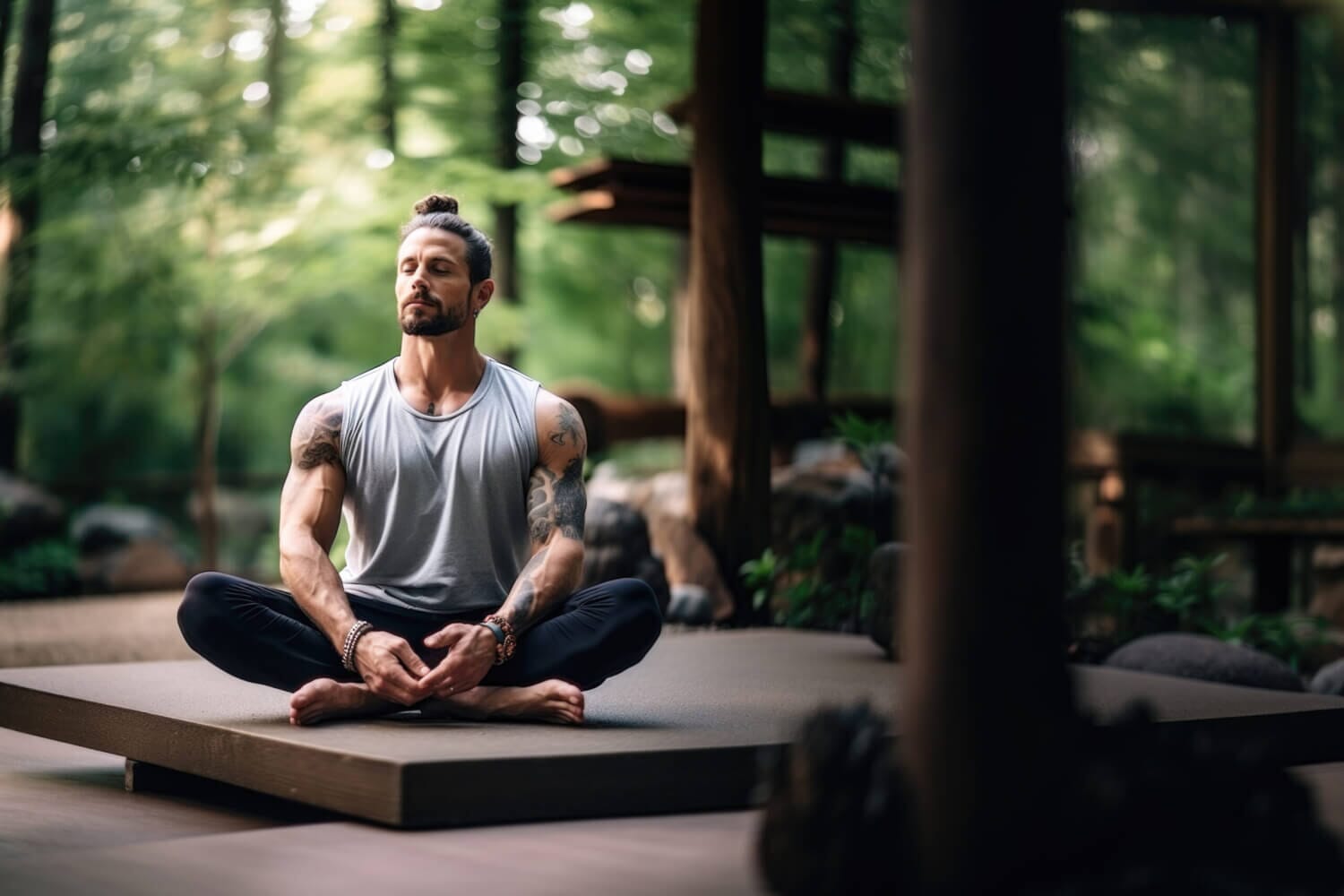
by Stefan
on Sep 07 2023
Meditation and Concentration: Improve your focus
Everyday life requires us to be highly focused at all times – whether at school, work, or university. Countless external and internal distractions make it difficult for people to concentrate properly. This article shows you why meditation can help you focus more easily.
1. Overview of meditation and concentration
There are many different tips for improving your concentration. Regular meditation is at the top of the list. Experts have also found that a few quiet minutes help strengthen focus. This is because we arrive in complete silence, let our thoughts drift, and no longer pay attention to external factors.
2. Why it is important to focus on the essentials
The problem for many is that they focus on dozens of different things at once. At first, you might think this will help you get things done faster. However, this is a mistake. Anyone who finds themselves in the following situations can improve their concentration:
Performing different tasks simultaneously
Getting bogged down because there are too many to-dos in your head and everything is started in parallel
Problem concentrating on what is really important
Setting priorities
Once you know this, you can achieve better results and avoid distraction through increased concentration. Furthermore, with frequent repetition, your stress level will decrease.
3. How can you start meditating?
All beginnings are difficult. If you've wanted to start meditating for some time, but you've always made excuses or encountered problems, the following tips can help.
a) Instructions for correct breathing technique
When you meditate, silence isn't the only important thing. To reach the deepest level and truly feel yourself, breathing exercises (pranayama) are necessary. There are various breathing techniques that can be practiced depending on your preferences.
Breathe in and out deeply, concentrating on the breath flowing through your nose into your belly, and do the same when you breathe out.
Breathing techniques such as alternate nostril breathing, fire breathing or Wim Hof will bring you even more peace.
You'll see that starting with the right breathing exercise makes a big difference. Reciting a mantra (such as the Gayatri Mantra or Om) can also be supportive and increase your ability to calm down.
b) The best way to calm the mind and let go
As already emphasized, meditation is a beneficial way to do something good for yourself and bring calm into your system. The advantage is that even short meditation sessions can make a big difference. In addition to meditation, mindfulness is also very helpful. If you practice mindfulness during meditation, you can better integrate this state into your daily life – this allows your mind to focus on just one thing and let go of all unnecessary thoughts.
If it helps, you can write down all your thoughts and then release them again through visualization during meditation. To do this, you can imagine packing all the thoughts that no longer serve you into a box and then burning it in a fire.
c) Practice regularly to achieve the full effect
One of the most important points is that you meditate regularly. Especially at first, it can be difficult to sit down. Therefore, you should establish a pleasant ritual right from the start so that it's fun and you can enjoy the time for yourself. Combining yoga and meditation is helpful for landing in your body even more easily. Essential oils or incense sticks can also create an even more soothing atmosphere.
4. How can meditation help you improve your concentration?
Awareness of the great effect meditation has on the mind, body and soul is growing ever greater – especially in the brain, great effects can be observed.
a) Reduced distractibility and more focus on one thing
In these fast-paced times, our attention spans are becoming increasingly shorter. You'll notice this, for example, when you find yourself completely distracted again within just a few minutes. We can't completely change the external world, but we can manage to focus our energy and attention on one thing. This is why meditation can bring about a profound change in your life. During your practice, you can practice concentrating on a mantra, your breath, a sound, or a visualized image. This ensures that you can focus on one thing more quickly in everyday life.
Further tips:
Try to organize your outside space so that you are not constantly distracted, for example, putting away your mobile phone, turning off the TV, etc.
Practice this consciously every moment you can think of it. Ask yourself where your thoughts have been and consciously refocus them on the here and now. This will lead to more relaxation.
If you incorporate a few asanas on the mat (Hatha Yoga, Yin Yoga, etc.) every day, you can land even more in your body and let yourself fall into meditation even more easily.
b) Increase in endurance and mental resilience
Those who meditate daily and practice focusing their attention on themselves or something external (work, studying, etc.) will become more resilient over time. On the other hand, if you constantly have ten things on your mind, you won't have enough energy available for mental stress or challenges. All your energy dissipates and is no longer available for the truly important things. With a little practice, you'll notice that your resilience level increases significantly again.
5. Tips for better concentration
To improve your attention and concentration, the following tips will help you as a beginner:
a) Eliminate unnecessary distractions
Constantly being exposed to countless stimuli can make it harder for you to concentrate. Therefore, it's advisable to put away all distractions (such as your cell phone, distracting music, or the radio) during a concentration phase. If you're working on a computer, you can close the tabs you don't need.
b) Set goals and try to achieve them
To help you focus better on the here and now, it is advisable to write down a list of your goals before work, studying or doing homework.
What do you want to achieve in this hour/on this workday?
What's on the to-do list?
What needs to be completed today?
This way you can work through everything little by little and concentrate fully on it.
It is also recommended that meditators write a list of the things they want to do afterward – this way, these commitments are not constantly on their minds.
c) Use positive visualization techniques
Images created in the mind can affect mood and well-being. For example, while meditating on the cushion , you can visualize a beam of light flowing through your entire body, flooding it with love and calm. This promotes relaxation. You can also imagine your brain glowing with a golden light, which will help you concentrate better. You can also visualize yourself successfully accomplishing everything in your mind's eye, thereby inviting self-confidence. It's also great to focus on your third eye (located between your eyes) and send energy there to strengthen your intuition.
In the evening, it can be helpful to mentally visualize the past day to help you close it off on a positive note. These active techniques train your mind and focus.
Conclusion
Regular meditation has a profound impact on your concentration. First, it helps you be more present in the moment. Second, it also helps you let go of distractions more easily and focus on what's truly important.
A great final tip: In addition to these points, you should also pay attention to your diet. B vitamins can have a positive effect on brain health.
Do you meditate regularly? If so, has it had a positive effect on your concentration span?
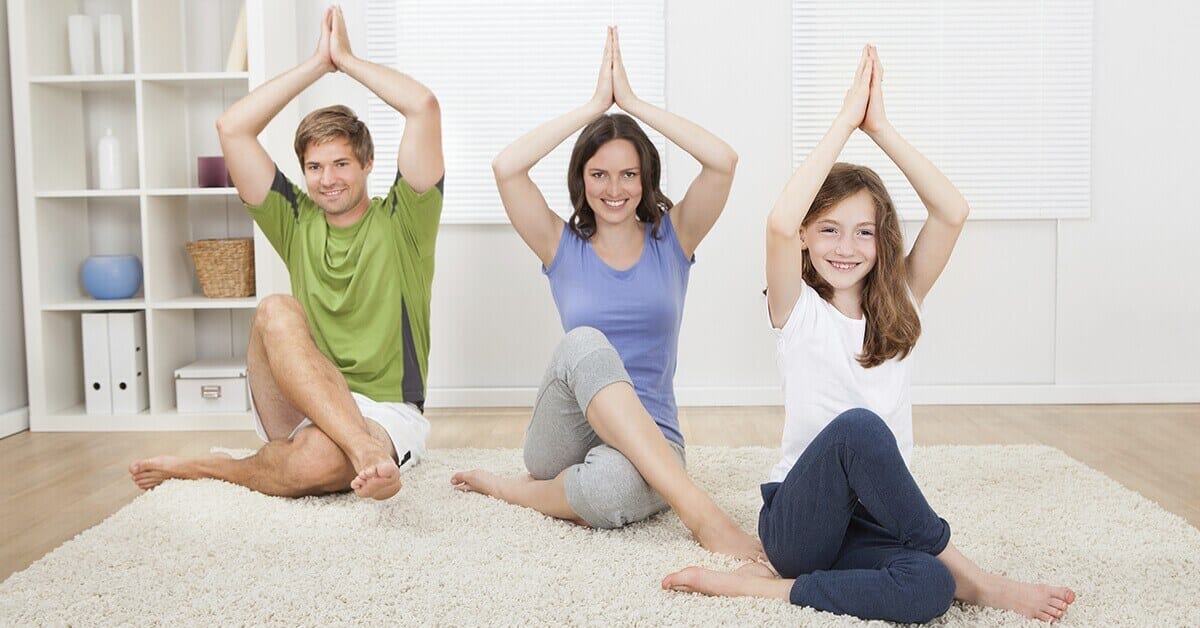
Is yoga at home something for you?
by Nick
on Aug 12 2023
Yoga at home
Practicing yoga at home is a tempting idea, as it offers numerous benefits—especially if you're already familiar with it. Those who work shifts or long hours often don't have time to attend morning or evening classes. If you have small children and a busy schedule, the option of practicing yoga at home is all the more appealing: You dream of creating personal space for yourself and then working in peace. Finally having time for yourself!
However, this idea is deceptive if you're not consistent: It's best to train at home at specific times and make sure no one disturbs you during those hours. Your workout doesn't have to be long; maybe you only have 15 minutes in the morning; but if you do it several times a week, you can easily reach a total of half an hour, an hour, or even an hour and a half. So keep at it!
We have compiled a few points here to help you see more clearly whether yoga at home is suitable for you:
You can practice yoga at home if you
don't have time for a group
would like to practice with your children
already have previous knowledge of yoga or at least a very good body awareness
are disciplined enough
you can clear some space
find the peace and quiet you need for your exercises or demand it from your family
has a few utensils such as at least one exercise mat
Yoga at home has several advantages and (like most endeavors) some disadvantages:
Time : You practice whenever you have time, and only as much as you want. This saves you travel and fuel, and you're not committed to a routine that usually lasts 90 minutes. You can also practice smaller sessions several times a week instead of just attending one appointment.
However, some people cope better with a fixed weekly appointment; discipline at home is often lacking.
Costs : You save the often quite high course fees, and of course also travel costs.
To do this, you will need to purchase a mat, possibly blankets, pillows, clothing, and other equipment, as well as books and DVDs with instructions.
Teacher : Many people prefer to be instructed by a teacher rather than learning the instructions on their own at home. However, you'll then have to implement what's required in the class, even if it's not your style.
Skills : You only need to do exercises at home that you feel confident and comfortable with.
On the other hand, the challenge of trying new things is missing – unless you're curious (and cautious). You should definitely avoid exercises that put you and your body at risk – you need someone by your side to support you or tell you if your posture is correct (very few people own a large wall mirror at home).
Progress : Due to the lack of guidance, there is usually less progress, whether in performing a familiar exercise or in learning new ones with a higher level of difficulty.
The alternative: You create your own training plan.
Environment : It's not always easy to create a calm, neutral environment at home. Some people prefer to attend a class, partly to unwind. However, we offer several options for creating a dreamy, harmonious atmosphere: Try our wonderful candles, for example.
Practicing yoga at home makes sense if it feels right for you and you're aware of your physical characteristics—including your body's limits. Yoga isn't about competition or going faster, higher, further, but rather a very individual form of movement and harmony. No one is like you, not even in yoga!
If you have any questions, we welcome your input and will be happy to answer them!
©iStock.com/AndreyPopov

by Nick
on Aug 12 2023
Yoga and healthy eating
Anyone who practices yoga intensively will sooner or later consider the topic of nutrition. This is not only because it quickly becomes clear that one should avoid heavy meals about two hours before a yoga class, as a full stomach interferes with the execution of the asanas . Regular yoga practice changes the body and the awareness of one's own needs. Yogis therefore live more mindfully, attentively, and healthily than many of their peers who do not practice yoga. What should be considered in a yogic diet? Which foods do yoga teachers recommend, and which supposedly indulgent foods should be avoided?
The three-part food system
In the philosophy of yoga , three types of food are distinguished based on their specific properties: tamasic food (represents inertia), rajasic food (represents restlessness) and sattvic food (provides lightness).
Tamasic food is characterized by a lack of important vital nutrients. Instead of providing energy, it drains the body and also causes the mind to become sluggish. Tamasic foods include unripe fruit, overcooked food, and convenience foods. Meat and fish are also considered tamasic and should be avoided according to yoga teachings. Alcohol, tobacco, and drugs are also tamasic.
Rajasic food causes a restless mind and body. Rajasic foods include foods containing caffeine, as well as very spicy foods, sugar, and white flour. Foods eaten too quickly and not chewed thoroughly are also rajasic and should be kept to a minimum.
Sattvic food is considered the ideal diet in yoga. Sattvic foods provide new energy, calm the mind, and contain many vital nutrients. Fresh produce, preferably raw, contains the most vital energy, known as "prana." Whole grain products, vegetables, nuts, fruit, milk, potatoes, and legumes are sattvic and are essential to a yogi's diet.
Diversity instead of one-sidedness
Yogic nutrition is not a diet that involves following a fixed menu as precisely as possible. The teachings of yoga recognize that every body is unique and that people need different amounts of energy in varying amounts at different stages of life. Just as yoga practitioners gradually learn to gently ease into their asanas and perform them correctly and mindfully, yogis develop a deeper awareness of their body and become increasingly aware of which diets are beneficial to their health and spiritual well-being. Over time, sattvic foods will naturally take a central place in their daily diet.
Drink plenty and eat peacefully
Yogis should drink around three liters of water or herbal tea per day. Those who prefer more flavorful drinks can flavor plain water with a few fresh mint leaves, lemon slices, some ginger, or fresh cucumber slices. When choosing food, natural and fresh foods are preferable. Occasional fasting helps healthy people detoxify and relax the body and mind. Even though there are no rigid rules for a healthy yoga diet, many yogis find the following rule of thumb helpful: Fill your stomach halfway with food, a quarter with water, and leave the other quarter empty. This activates mind and body. In yoga, abstaining from meat is connected to the ideal of a non-violent life. However, a diet without meat and fish also has health benefits, as studies repeatedly confirm.
Those interested in learning more about healthy eating and yoga can ask their yoga teacher for specific tips. Since there are some parallels to Ayurvedic nutrition, attending an Ayurvedic cooking class is also recommended. Some holiday hotels and private clinics offer Ayurvedic and yogic dishes. Those who want to fundamentally change their diet can take a relaxing yoga retreat as an opportunity to experience the benefits of healthy eating for themselves in an energizing atmosphere.
©iStock.com/maramicado
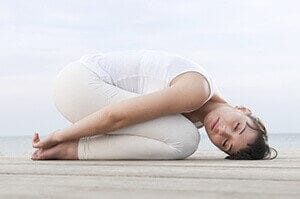
Every beginning is surprisingly easy: Yoga for beginners – Asanas (physical exercises)
by Nick
on Aug 12 2023
Yoga for beginners
The wounded peacock pose, one-handed tree pose, or scorpion pose in a handstand: Don't worry, as a yoga beginner, no one is demanding these asanas from you. Very few yogis have mastered these extreme poses. Yoga doesn't require performance pressure: everyone can do it their way. Simply start by gently increasing your flexibility with simple basic exercises and focusing on the beneficial effects of the asanas. Everything else will follow with time.
Basic yoga poses suitable for beginners
There are a dozen or so asanas that, when performed in a relaxed sequence, are particularly suitable for beginners. Some look more complicated in photos or at first glance than they actually are. You can adapt the exercises depending on your flexibility and physical condition – ideally with qualified instruction. As a beginner, learning your first asanas at home is possible, but you won't have external control over the movement sequence and breathing. Since no one will give you tips, you're on your own and should therefore be particularly careful. Videos are often helpful, and a large mirror can also give you insight into whether you're performing the physical exercise correctly. We present five asanas that should be an integral part of your exercise program.
The Sun Salutation (Surya Namaskar)
This holistic, dynamic, core exercise invigorates you physically, mentally, and spiritually. Your circulation gets going, and you immediately feel renewed vitality and activity. You can perform the Sun Salutation movements in the morning to start the day with renewed vigor, or you can use them in the evening to release new energy. With its 12 movements, the Sun Salutation is an ideal warm-up exercise that loosens you up, has a harmonizing effect, and prepares your body for further asanas.
The Candle Pose (Sarvangasana)
The candle pose, also called inversion pose, doesn't have to be perfectly straight right away. It takes a little patience and practice until you can balance yourself properly and stretch your legs and toes upwards for between 10 and 60 seconds. Advanced yogis stay in this pose for three minutes, which simultaneously relaxes and stimulates the entire body.
The Pliers Pose (Paschimottanasana)
The exercise is also known as a seated trunk bend or forward bend. It's important to perform it slowly and smoothly. Bend forward, vertebra by vertebra, keeping your legs straight. A single jerky movement can easily lead to strains, so don't force it! Progress is rapid with the forward bend, so even most beginners can quickly touch their toes while resting their head on their knees. The pincer movement strengthens the internal organs and abdominal muscles, relieves tension in the spine and legs, and has an overall revitalizing effect.
The Tree (Vrkasana)
This asana helps you achieve inner and outer balance: The tree pose is an excellent posture and balance exercise that tones the body, strengthens the leg muscles, promotes self-confidence, and harmonizes the soul. When performing it, you must focus entirely on yourself and your goal. Finding your balance more and more confidently and maintaining it for longer and longer periods of time is an incredibly motivating experience.
Child's Pose (Balasana)
Curled up like a child in the womb, relax completely and recharge your batteries: This exercise, also known as "Curled Leaf Pose," releases physical and mental tension and has an almost therapeutic effect. If you conclude your yoga routine with this asana and remain in the pose for a few minutes, you'll feel reborn—even if you were tired and worn out at the beginning.
What (not only) beginners should pay attention to
Whatever asanas you choose, don't perform them immediately after eating. Otherwise, you'll quickly experience an unpleasant feeling of fullness, perhaps even accompanied by nausea. Wait an hour and a half, or even two hours, so that the last meal won't sit heavily on your stomach.
Make sure the environment is comfortably warm. Yoga isn't a sport, so the room shouldn't be too cold.
Start your yoga program with a relaxation exercise, a breathing exercise or meditation to calm down.
Don't force yourself to hold a position for a particularly long time or perform a stretch until you feel pain. This is a mistake, as it's counterproductive. With composure, you'll reach your goal more safely.
Put together a program that combines movements and countermovements to balance things out. For example, if you arch your back during one exercise, a rounded-back exercise will balance things out.
As a yoga newbie, you're best off starting out in a yoga class. There, professional teachers will guide you and help you internalize the exercises.
©iStock.com/ Ridofranz

Children's yoga in kindergarten: islands of calm for the little ones
by Nick
on Aug 12 2023
Children's yoga in kindergarten
Consistently high noise levels, stressed teachers, and children who struggle to relax in the hectic environment: This is what everyday life looks like in many daycare centers with large groups. This makes it all the more important to offer children periods of relaxation. A great way to gain strength through play, but also to reduce aggression and stress, is children's yoga .
Why children's yoga has a beneficial effect on kindergarten children
Kindergarten children and teachers benefit equally from yoga classes, as the adults also gain energy and find a path to greater serenity during the sessions. For this reason, children's yoga is now a recognized method used in early childhood and primary school education, along with progressive muscle relaxation and autogenic training. Its diverse effects have been scientifically researched and confirmed, so that children's yoga is finding its way into more and more kindergartens and primary schools. When children are introduced to yoga at preschool and primary school age, they develop their body awareness through play. They improve their coordination, motor skills, flexibility, and posture, become more aware of themselves, and activate their body's own strengths. Yoga releases tension, and children practice relaxed concentration for longer periods.
How to integrate yoga into the daily routine in kindergarten
The teaching formats vary depending on the type of children's yoga being introduced in the kindergarten. Classical Hatha Yoga should be introduced by trained children's yoga teachers. In many larger cities, yoga schools specializing in children's yoga work closely with kindergartens and elementary schools. Alternatively, parents with appropriate training can also volunteer to teach. This can happen, for example, during a project week promoting physical activity, during which the kindergarten teachers also receive training. This allows them to continue the yoga play sessions with selected children's yoga elements after the project ends. Motivated teachers also have the option of training as children's yoga instructors, enabling them to teach kindergarten children independently.
What time frame is ideal for children’s yoga in daycare centers
In daycare centers, a duration of around 45 minutes has proven ideal for yoga classes, yoga play sessions, and yoga fantasy sessions for 3-6 year-olds. Preschool and elementary school children can also concentrate on the yoga program for a full hour. A good time of day is late morning, after plenty of play and activity, but before lunch. To "wind down" and prepare for the yoga class, it usually begins with relaxation and breathing exercises. These child-friendly asanas should only last a few minutes in total and can be framed by a short, imaginative yet calming nature story. The following asanas can build on this story, for example, with the sun, whose morning greeting tickles the cat and wakes the dog or the lion. When the sun is high in the sky, it crosses a bridge and finally sets behind a large tree. At sunset, exactly 45 minutes of relaxation have flown by, and it's slowly time to prepare for lunch. If the yoga class takes place in the afternoon, you should allow your lunch to sink in first, because yoga and a full stomach do not mix.
How to make yoga for kindergarten children even more varied
It doesn't always have to be a traditional yoga class, as individual elements can be easily combined with movement games and dances without a fixed schedule. Even the popular circle of chairs works well if yoga mats or cushions are placed on the floor instead of chairs, and the children assume a comfortable yoga position . Educators who want to offer children's yoga as part of their physical activity program should hold a parents' evening on the topic and get the parents on board. Then the children and parents can practice the exercises together at home on weekends and during school holidays.
©iStock.com/_jure

by Nick
on Aug 11 2023
What is Karma Yoga – what do you need to know?
Karma Yoga, as the name suggests, is a slightly different style of yoga that you don't necessarily have to practice on a yoga mat . Karma Yoga is one of the four paths of yoga, practiced by many yoginis and other spiritual practitioners. In this article, you'll learn the most important information and find out why it's worth integrating Karma Yoga into your daily life. Because, as the saying goes, one good deed a day makes your life much more beautiful.
Definition: What exactly is Karma Yoga?
Many people aim to achieve enlightenment. Karma Yoga could be one possibility. Along with the three other paths: Raja Yoga (the traditional path with various breathing exercises, asanas, and meditation), Bhakti Yoga , and Jnana Yoga, Karma Yoga is considered an effective way to live a more selfless and mindful life.
Karma Yoga can also be translated as "yoga of action," and the principle of cause and effect plays a role in this yoga path. The goal is to accumulate good karma and thus live a good life and serve others.
A very popular and wise yoga master, Swami Sivananda, always explained that he taught young yogis "bedpan yoga." According to his philosophy, students could best pursue the path of yoga by serving others. He implemented this by having students empty the pans of sick people in hospitals. This daily good deed naturally had a direct impact on the yogis' spirituality.
Briefly explained: What is karma?
In this context, we would like to briefly explain what karma means. It is also described as the law of cause and effect. Every action has a consequence. The consequence ensures that further action is taken – thus, it describes a continuous sequence of actions. This law is observed primarily in Hinduism and Buddhism, but it is also one of the universal laws of nature that shape every human life, albeit unconsciously.
Anyone who follows this law knows that every action plants a seed and the consequence will occur sooner or later (in some cases not until the next life).
These facts shouldn't be frightening. Everyone makes mistakes, and everyone has done things they later regret. Nevertheless, it's advisable to give your life a new meaning now. This can be achieved with simple tips that you'll learn in the following section.
How can you integrate Karma Yoga into your everyday life?
Now that you understand that you can consciously control your life through your actions, you should choose them wisely. With a little practice, this becomes much easier; thus, the first step toward the divine becomes easier to implement.
a) Act selflessly
One of the most important points is that you begin to switch off your ego and act from a selfless attitude. This isn't easy, especially at first. With the help of various meditation exercises on the cushion , mantras, or asanas, you will feel the call of your heart more strongly; the ego will fade into the background.
In this context, reflecting on one's own behavior can be very important. We often act ego-driven, even though we don't intend to. This is because we are shaped by patterns or beliefs that make us act this way. However, once these are resolved, our behavior can change, and selfless action becomes much easier, with more dedication and love.
Acting selflessly means that we don't necessarily put our desires first. At the same time, it doesn't mean we have to neglect ourselves.
b) Do something good every day
A great exercise can be to consciously do something good every day. This can be anything. Whether it's helping an elderly woman across the street, offering someone a listening ear, or giving a poor person a meal. Even a smile can often work wonders.
This point makes such a difference and yet it is easy to integrate into everyday life.
c) Help others: Discover your social side
Depending on your circumstances, you can get involved in social activities. You can support projects with money or your time. If you're even more committed, you can start your own project.
d) Increase self-love, basic trust and equanimity
To be able to act authentically and honestly, it's important that you strengthen your self-love and self-esteem. Only then will you realize that you're doing things with a different motivation. You'll be able to decide much more clearly what you're doing and why, and thus act even more selflessly.
In addition to self-love, equanimity and fundamental trust are also the cornerstones of Karma Yoga. Those who trust in life can act with significantly less selflessness and fear. Equanimity describes a sense of serenity: Those who are equanimous can remain more at peace with themselves and more positively in difficult situations. You no longer judge situations as "good" or "bad," which brings a great deal of lightness into your life.
ATTENTION: You should avoid this
When people do something good, they sometimes expect external recognition. This means that you perform a good deed and then want to be appreciated. This is completely human, but it shouldn't be the main focus. It's much more important that you do it for the sake of satisfaction. You'll find that over time, you'll feel so much gratitude and satisfaction from the act alone that you'll no longer need external recognition.
Do you already practice Karma Yoga? If so, what do you do and how are you doing with it?

